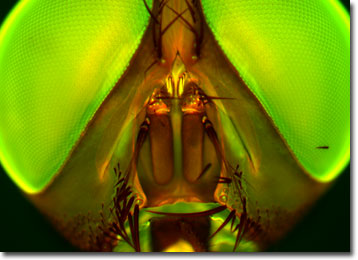Fluorescence Digital Image Gallery
House Fly Face
The often maligned common house fly is generally thought to be a nuisance and vector for many diseases that affect both humans and animals. Flies lay up to 1,000 eggs in some of the most undesirable settings such as garbage, decomposing plant and animal matter, spoiled food, and manure. Although more abundant in the warm spring and hot summer weather, house flies may exist year-round in temperate climates, where their life cycles occur every eight days.

House flies are among the speediest of insects with an average speed of about five miles per hour (mph), with bursts to 15 mph when threatened. The rapid beating of their wings (about 1,000 times per second) is responsible for the buzzing noise that accompanies a close fly-by. The sensitive antennae of the fly are responsible for detecting both food sources and changes in air currents, which signal the approach of enemies.
The life span of a typical fly is about 21 days, but they can live much longer in cool weather, although their metabolism and active movement is severely reduced. The average fly is between five to eight millimeters in length, and they range from gray to dark brown with dark stripes on the thorax. The abdomen is colored yellow on the sides, and the eyes are often red or green. The mouth forms a fleshy proboscis, which is used to gather food. The larvae are cylindrical white maggots that average about a centimeter in length and taper off at the ends. Puparia are reddish-brown and are about half the size of the larvae.
The specimen presented here was imaged with a Nikon Eclipse E600 microscope operating with fluorite and/or apochromatic objectives and vertical illuminator equipped with a mercury arc lamp. Specimens were illuminated through Nikon dichromatic filter blocks containing interference filters and a dichroic mirror and imaged with standard epi-fluorescence techniques. Specific filters for the fly face specimen were a UV-2E/C, B-2E/C, and a Y-2E/C. Photomicrographs were captured with an Optronics MagnaFire digital camera system coupled to the microscope with a lens-free C-mount adapter.
BACK TO THE FLUORESCENCE DIGITAL IMAGE GALLERY
